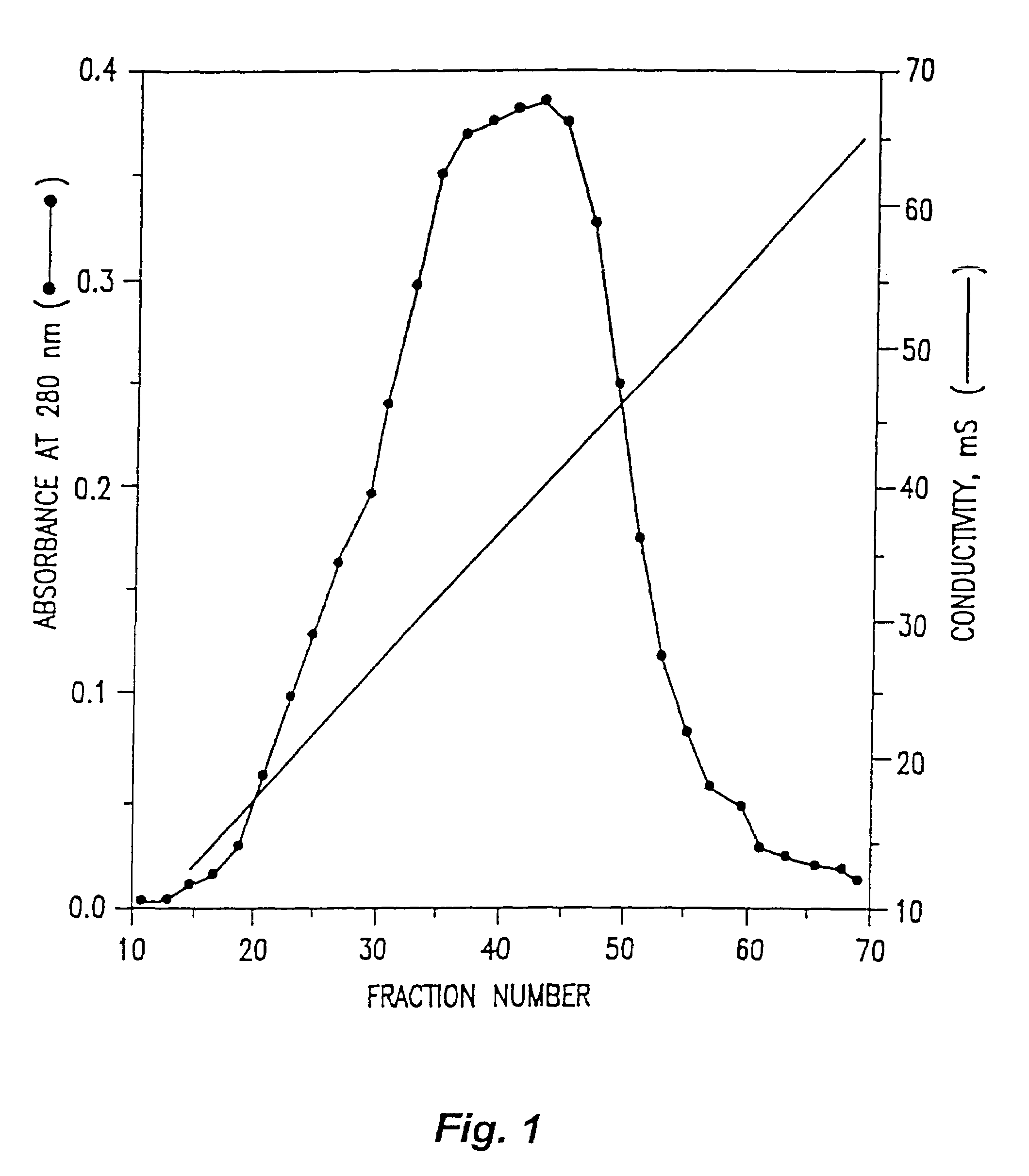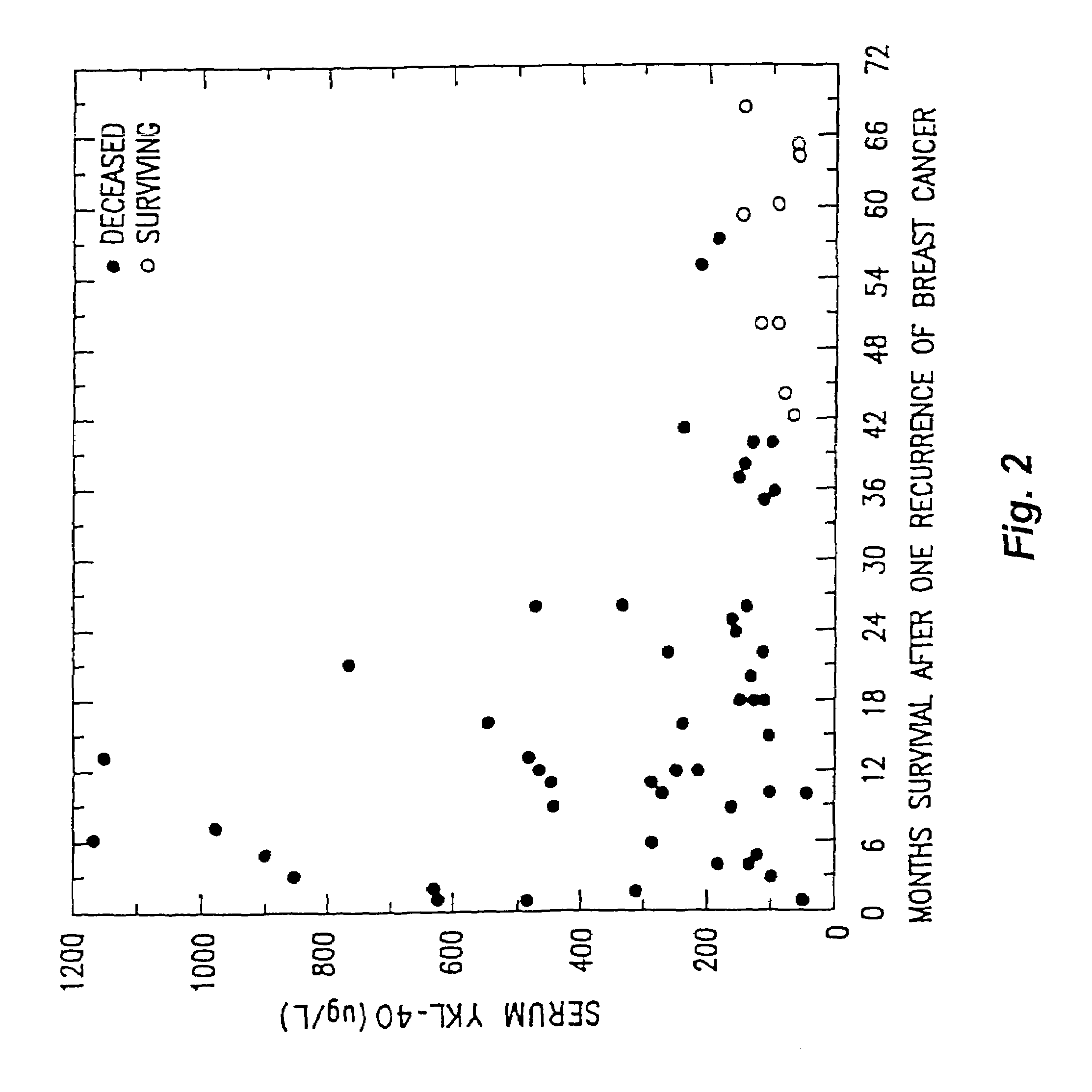YKL-40 as a marker and prognostic indicator for cancers
a prognostic indicator and cancer technology, applied in the field of ykl-40 as a marker and prognostic indicator for cancer, can solve the problems of unresolved prognostic value of a number of known markers, inability to predict the course of disease for all breast cancer patients, and difficulty in predicting patients at risk
- Summary
- Abstract
- Description
- Claims
- Application Information
AI Technical Summary
Benefits of technology
Problems solved by technology
Method used
Image
Examples
example 1
Isolation and Purification of YKL-40 from Human Osteosarcoma Cell Line MG63
[0199]YKL-40 was purified from serum-free conditioned medium of the human osteosarcoma cell line MG63 (MG63 cells were obtained from the American Type Culture Collection, Rockville, Md.) (Johansen et al. (1993) Br. J. Rheumatol., 32: 949–955). Cells were cultured in 100 mm dishes with RPMI 1640 medium containing 10% newborn calf serum, 100 Units / ml penicillin, 100 μg / ml streptomycin, 50 μg / ml vitamin C, and 1 μg / ml vitamin K1. The cultures were incubated at 37° C. in a humidified atmosphere of 10% CO2. When the cells reached confluence, the culture medium was removed and the cell layer was washed twice with 10 milliliters (ml) of phosphate buffered saline.
[0200]Ten mls of serum-free RPMI 1640 media containing 50 μg / ml vitamin C and 1 μg / ml vitamin K1 was then added to each dish. 48 hours later, conditioned medium was decanted from each dish and replaced with 10 ml of fresh serum-free medium containing the sam...
example 2
Preparation of Assay Samples for Radioimmunoassay
[0205]A) Assay Sample Sources
[0206]Assay samples were obtained from the sera of 49 patients with inflammatory or degenerative joint diseases (34 women and 15 men, aged 23–80 years with a median age of 65 years) (Johansen et al. (993) Br. J. Rheumalol., 32: 949–955). 29 patients had RA, 7 had osteoarthritis, 4 had crystal arthritis, 2 had psoriatic arthritis, 5 had reactive arthritis and 2 had monoarthritis. Diagnoses were based on the criteria described in Arnett, et al. (1988) Arthritis Rheum. 31: 315–324 (American Rheumatism Association Standards), clinical and radiographic examinations of the knees, and direct microscopy of synovial fluid. The patients had a serum CRP level of 25–1600 (median 165). 34 patients were taking non-steroidal anti-inflammatory drugs and 17 were receiving slow acting antirheumatic agents. 15 patients had received glucocorticoid therapy systemically or locally within the past 3 months. The inflammation of t...
example 3
Preparation of Labeled Antigen and Antibodies for Radioimmunoassay for YKL-40
[0209]A) Preparation of Radioiodinated YKL-40
[0210]Purified YKL-40 was labeled with 125, (sodium salt, Amersham, UK) according to the Iodogen method described by Johansen et al. (1993) Br. J. Rheumatol., 32: 949–955. Specifically, 10 μg YKL-40 was incubated for 10 minutes with 18.5 MBq 1251 using 2 μg of iodogen (Pierce and Warriner, Chester, England, UK) as oxidant in a reaction volume of 110 μL. Iodination was terminated by moving the reaction mixture from the iodogen tube. The labelled YKL-40 was separated from free iodine by gel filtration using a SEPHADEX G-25 column (1×12.5 cm, from Pharmacia) equilibrated with assay buffer (16 mM sodium phosphate buffer pH 7.4, 0.12 M NaCl, 0.1% (w / v) human serum albumin). The calculated specific activity of the labelled was about 15 Ci / g. The elution position of YKL-40 (purified) and of YKL-40 taken from the serum of a patient with RA is shown in FIG. 1.
[0211]B) Pre...
PUM
| Property | Measurement | Unit |
|---|---|---|
| concentrations | aaaaa | aaaaa |
| concentration | aaaaa | aaaaa |
| concentration | aaaaa | aaaaa |
Abstract
Description
Claims
Application Information
 Login to View More
Login to View More - R&D
- Intellectual Property
- Life Sciences
- Materials
- Tech Scout
- Unparalleled Data Quality
- Higher Quality Content
- 60% Fewer Hallucinations
Browse by: Latest US Patents, China's latest patents, Technical Efficacy Thesaurus, Application Domain, Technology Topic, Popular Technical Reports.
© 2025 PatSnap. All rights reserved.Legal|Privacy policy|Modern Slavery Act Transparency Statement|Sitemap|About US| Contact US: help@patsnap.com



